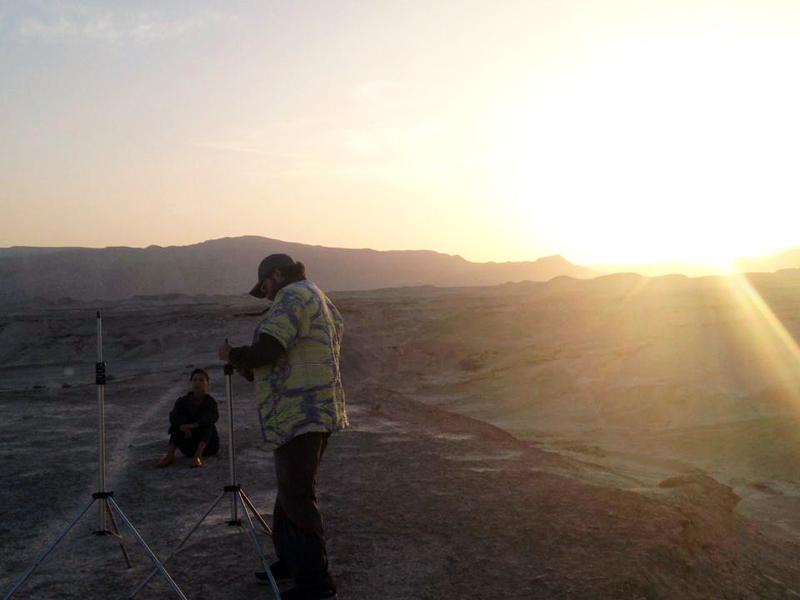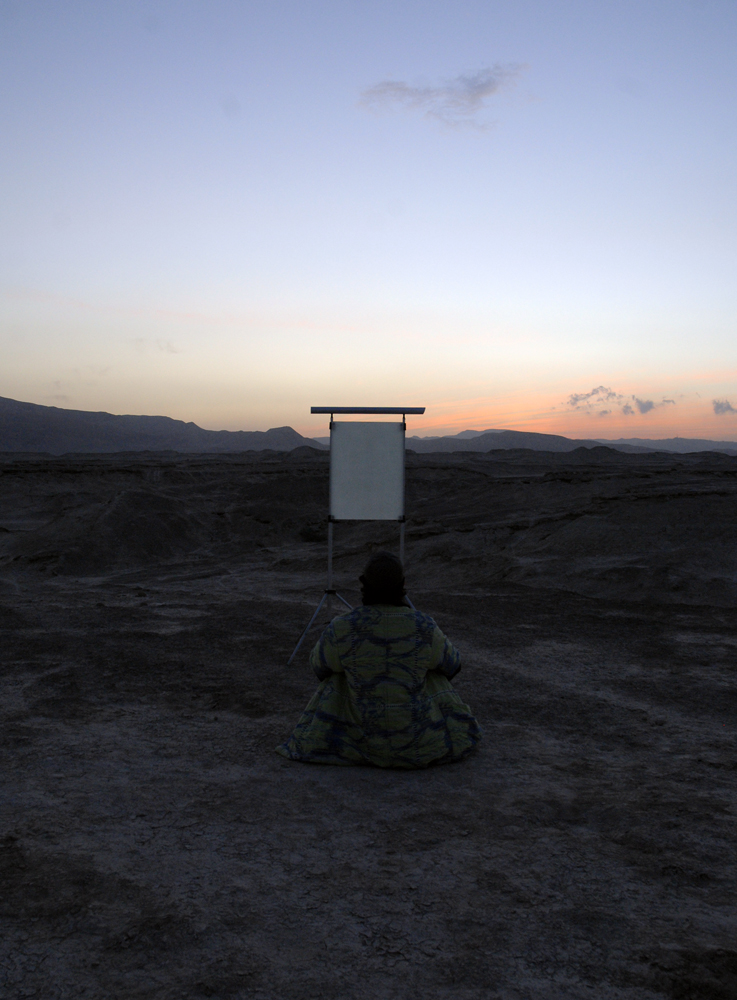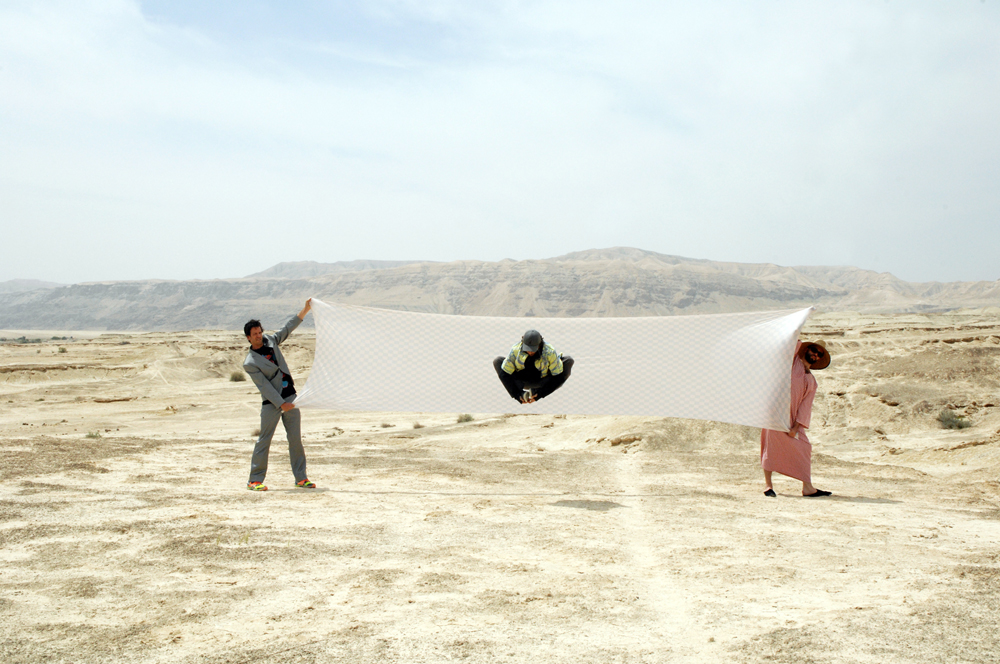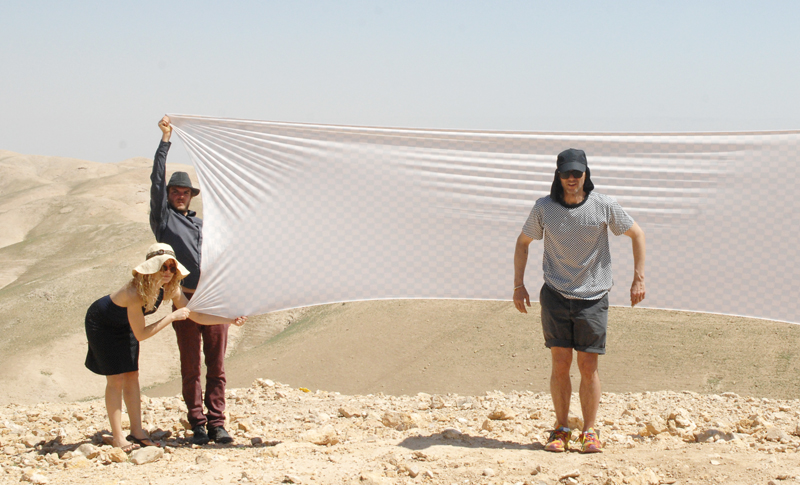http://eternalinternetbrotherhood.tumblr.com/
The photographs making up Oracle Blue Windows, are documentation of a performance done on site. A photo-sensitive screen was set up in the barren landscape, on which are “painted” nine different symbols in light using a UV laser. The ephemeral “space-time emoticons” are now photographically fixed images, as the Dead Sea landscape takes on new narrative meanings.

Oracle blue window ceremony, 2014, Dead Sea region. Aluminium, tripods, blue phosphor paint on Plexiglas, UV led.

Oracle blue window ceremony, 2014, Dead Sea region. Aluminium, tripods, blue phosphor paint on Plexiglas, UV led.

Oracle blue window ceremony, 2014, Dead Sea region. Aluminium, tripods, blue phosphor paint on Plexiglas, UV led.

Oracle blue window ceremony, 2014, Dead Sea region. Aluminium, tripods, blue phosphor paint on Plexiglas, UV led.

Oracle blue window ceremony, 2014, Dead Sea region. Aluminium, tripods, blue phosphor paint on Plexiglas, UV led.
The Big Jump Experiment” is based on the idea of connecting geographical areas and ethnic groups using as a free and common background the popular white and gray checkerboard pattern representative of the “vacuum” in the Photoshop graphic software.
External Reference:
The Big Bounce is a hypothetical scientific model of the formation of the known universe. It is implied by the cyclic model or oscillatory universe interpretation of the Big Bang where the first cosmological event was the result of the collapse of a previous universe.[1]
Big bounce models have a venerable history and were endorsed on largely aesthetic grounds by cosmologists including Willem de Sitter, Carl Friedrich von Weizsäcker, George McVittie and George Gamow (who stressed that “from the physical point of view we must forget entirely about the precollapse period”).[2] The phrase itself, however, did not appear in the scientific literature until 1987, when it was used in the title of a pair of articles (in German) in Stern und Weltraum by Wolfgang Priester and Hans-Joachim Blome.[3] It reappeared in 1988 in Iosif Rozental’s Big Bang, Big Bounce, a revised English translation of a Russian book (by a different title), and in a 1991 article (in English) by Priester and Blome in Astronomy and Astrophysics. (The phrase apparently originated as the title of a novel by Elmore Leonard in 1969, a few years after increased public awareness of the Big Bang model in the wake of the discovery of the cosmic microwave background by Penzias and Wilson.)
Martin Bojowald, an assistant professor of physics at Pennsylvania State University, published a study in July 2007 detailing work somewhat related to loop quantum gravity that claimed to mathematically solve the time before the Big Bang, which would give new weight to the oscillatory universe and Big Bounce theories.[4]
One of the main problems with the Big Bang theory is that at the moment of the Big Bang, there is a singularity of zero volume and infinite energy. This is normally interpreted as the end of the physics as we know it; in this case, of the theory of general relativity. This is why one expects quantum effects to become important and avoid the singularity.
However, research in loop quantum cosmology purported to show that a previously existing universe collapsed, not to the point of singularity, but to a point before that where the quantum effects of gravity become so strongly repulsive that the universe rebounds back out, forming a new branch. Throughout this collapse and bounce, the evolution is unitary.
Bojowald also claims that some properties of the universe that collapsed to form ours can also be determined. Some properties of the prior universe are not determinable however due to some kind of uncertainty principle.
This work is still in its early stages and very speculative. Some extensions by further scientists have been published in Physical Review Letters.[5]
In 2003, Peter Lynds has put forward a new cosmology model in which time is cyclic. In his theory our Universe will eventually stop expanding and then contract. Before becoming a singularity, as one would expect from Hawking’s black hole theory, the universe would bounce. Lynds claims that a singularity would violate the second law of thermodynamics and this stops the universe from being bounded by singularities. The Big Crunch would be avoided with a new Big Bang. Lynds suggests the exact history of the universe would be repeated in each cycle in an eternal recurrence. Some critics argue that while the universe may be cyclic, the histories would all be variants.[citation needed] Lynds’ theory has been dismissed by mainstream physicists for the lack of a mathematical model behind its philosophical considerations.[6]
In 2011, Nikodem Popławski showed that a nonsingular Big Bounce appears naturally in the Einstein-Cartan-Sciama-Kibble theory of gravity.[7] This theory extends general relativity by removing a constraint of the symmetry of the affine connection and regarding its antisymmetric part, the torsion tensor, as a dynamical variable. The minimal coupling between torsion and Dirac spinors generates a spin-spin interaction which is significant in fermionic matter at extremely high densities. Such an interaction averts the unphysical Big Bang singularity, replacing it with a cusp-like bounce at a finite minimum scale factor, before which the universe was contracting. This scenario also explains why the present Universe at largest scales appears spatially flat, homogeneous and isotropic, providing a physical alternative to cosmic inflation.
In 2012, a new theory of nonsingular big bounce was successfully constructed within the frame of standard Einstein gravity.[8] This theory combines the benefits of matter bounce and Ekpyrotic cosmology. Particularly, the famous BKL instability, that the homogeneous and isotropic background cosmological solution is unstable to the growth of anisotropic stress, is resolved in this theory. Moreover, curvature perturbations seeded in matter contraction are able to form a nearly scale-invariant primordial power spectrum and thus provides a consistent mechanism to explain the cosmic microwave background (CMB) observations alternative to inflation.

















